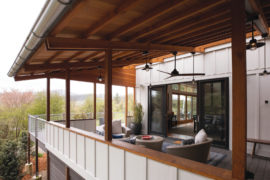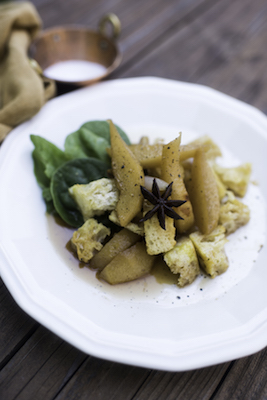In Walterville, east of Eugene, gardens may surround the house, but the focus of Lindsay Reaves’ attention is the creek that runs through the backyard. Subject to spring floods, summer marshiness and late fall drought, Reaves worked with the creek’s personality and moods to create a blousy European-style flower garden.
To protect the banks and to help guard against erosion, she lined the creek with rocks. “Water has its own mind,” she says. “You have to move with it.” After the 1996 floods, for example, she built rock steps into the creek areas that had been gouged by the fast water. During high water, the steps became a waterfall; in low water they resumed their function as stairs to the water so she could “weed” the creek during summer. Ever mindful of run-off and her downstream neighbors, she used organic soil and avoided chemical fertilizers. Despite the creative stream management, though, it’s the pastels of foxgloves planted along the creek’s banks that inspire awe among visitors.
Foxgloves became a passion for Reaves, 47, who started to collect native and hybrid seeds and varieties. The creek area became an experiment for what would work and what wouldn’t. Yet for all her devotion, she was not sentimental. “I became pretty attached to not being attached,” explains Reaves. “It if didn’t work, then I just pulled it out.”
The creek garden’s blooming splendor takes up only one part of the property’s 1.7 acres. Reaves’ husband, Tom Baumann, had planted trees and grasses before Reaves arrived on the scene. In the years since their marriage, they’ve added fruit trees, shrubs and perennials to attract wildlife and birds. The water remains as the primal magnet. “There’s the juxtaposition of water and its sound, the hardness of the banks and the graceful flowers. Something just happens.”
Chauncey, the Protégé
Flowers also grow in the Junction City garden tended by Chauncey Freeman, but there they appear in a supporting role with vegetables the lead. Freeman grew up on his parents’ five-acre farm in an area now surrounded by subdivisions. He started gardening at the age of 8. He was charged with taking care of the family’s tomato crop, and worked side by side with his parents to plant and nurture a bountiful vegetable garden that keeps family and friends stocked with food year-round.
All the gardening lessons were not lost on Freeman, an only child. While in high school, he participated in Future Farmers of America in the nursery landscape, dairy foods and environmental science categories. (In 2003, his Junction City chapter was named national champion in environmental science.) Last year he graduated from the University of Oregon with a degree in landscape architecture.
Today, Freeman’s half-acre vegetable garden is organized in beds arranged in squares, in which plants are grouped by growing patterns so they don’t compete with each other. For example, in square one are squash and other vine plants. In square two are tomatoes and peppers. Square three has broccoli and Swiss chard, and in the fourth square are root vegetables such as potatoes and onions. Other crops such as peas, beans and herbs are tucked in between. There are often three varieties of any given crop.
Berry patches and corn have their own plots, and grow adjacent to a half-acre orchard with apple, cherry and plum trees.
Freeman estimates that among the fruits and vegetables reaped by his family last year there were sixty quarts of tomatoes, forty jars of pickles, twenty jars of sauerkraut, thirty bags of corn, fifteen quarts of marionberries and raspberries. “Obviously, you have to dabble in the preservation of food,” says Freeman in a flash of understatement.
Freeman has since taken his avocation to vocation with his budding landscape business, Fifth Season.
Planting Particulars:
If you’re contemplating a foray into gardening,
here are some tips from Reaves and Freeman.
Take Your Time
Before starting a new garden, watch the site for a year so that you know what to address in all seasons.
good sunlight. Full sunlight is crucial for a successful vegetable garden.
Group and Water
Different plants have varying water requirements, so it is best for your garden (and the environment) to water plants individually. As a corollary to this advice, group plants with similar thirst.
Use Good Soil
What you put in is what you get out, so use the best materials and soil amendments available, such as organic soil and fertilizers. Start a compost pile and use the resulting riches for your garden.
Plant Native Species
Use native species, which are well-adapted for the area and don’t threaten other plants in the garden.
plan your pathways. Make paths wide enough to accommodate a wheelbarrow; put in a bench or two so you can enjoy the views.
Create Entryways
Create an entrance or some sort of statement that allows you to identify one area from another. Reaves’ entry is a wrought iron gate made by a local blacksmith.
Marigold Deterrence
Plant marigolds as a deterrent to bugs and pests.
experiment.
Be Flexible
Not everything works, and you need room to try different plants each year.
Be Resourceful
Look everywhere for ideas. Don’t forget to tap in to the vast resources offered by the state extension service. Administered by Oregon State University, the office offers advice and information on sustainability, soil amendments and testing, planting dates, shrubs, flowers, small woodlands, vegetables and other gardening subjects. It can also hook you up with local experts such as those in the master gardeners program, canning classes and other gardening interests. Find your local office and more information at extension.oregonstate.edu.









